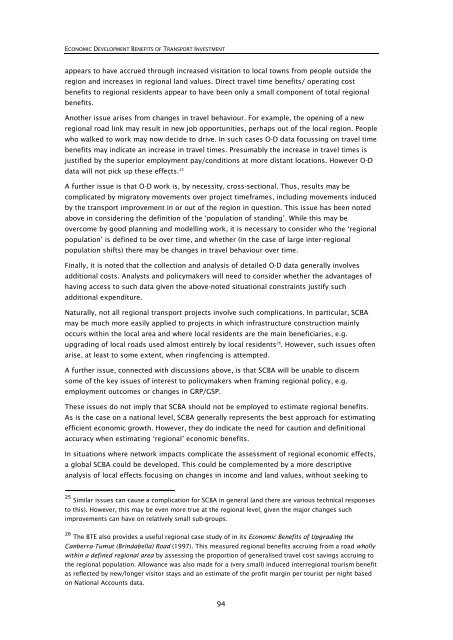Research 350 - NZ Transport Agency
Research 350 - NZ Transport Agency
Research 350 - NZ Transport Agency
You also want an ePaper? Increase the reach of your titles
YUMPU automatically turns print PDFs into web optimized ePapers that Google loves.
ECONOMIC DEVELOPMENT BENEFITS OF TRANSPORT INVESTMENT<br />
appears to have accrued through increased visitation to local towns from people outside the<br />
region and increases in regional land values. Direct travel time benefits/ operating cost<br />
benefits to regional residents appear to have been only a small component of total regional<br />
benefits.<br />
Another issue arises from changes in travel behaviour. For example, the opening of a new<br />
regional road link may result in new job opportunities, perhaps out of the local region. People<br />
who walked to work may now decide to drive. In such cases O-D data focussing on travel time<br />
benefits may indicate an increase in travel times. Presumably the increase in travel times is<br />
justified by the superior employment pay/conditions at more distant locations. However O-D<br />
data will not pick up these effects. 25<br />
A further issue is that O-D work is, by necessity, cross-sectional. Thus, results may be<br />
complicated by migratory movements over project timeframes, including movements induced<br />
by the transport improvement in or out of the region in question. This issue has been noted<br />
above in considering the definition of the ‘population of standing’. While this may be<br />
overcome by good planning and modelling work, it is necessary to consider who the ‘regional<br />
population’ is defined to be over time, and whether (in the case of large inter-regional<br />
population shifts) there may be changes in travel behaviour over time.<br />
Finally, it is noted that the collection and analysis of detailed O-D data generally involves<br />
additional costs. Analysts and policymakers will need to consider whether the advantages of<br />
having access to such data given the above-noted situational constraints justify such<br />
additional expenditure.<br />
Naturally, not all regional transport projects involve such complications. In particular, SCBA<br />
may be much more easily applied to projects in which infrastructure construction mainly<br />
occurs within the local area and where local residents are the main beneficiaries, e.g.<br />
upgrading of local roads used almost entirely by local residents 26 . However, such issues often<br />
arise, at least to some extent, when ringfencing is attempted.<br />
A further issue, connected with discussions above, is that SCBA will be unable to discern<br />
some of the key issues of interest to policymakers when framing regional policy, e.g.<br />
employment outcomes or changes in GRP/GSP.<br />
These issues do not imply that SCBA should not be employed to estimate regional benefits.<br />
As is the case on a national level, SCBA generally represents the best approach for estimating<br />
efficient economic growth. However, they do indicate the need for caution and definitional<br />
accuracy when estimating ‘regional’ economic benefits.<br />
In situations where network impacts complicate the assessment of regional economic effects,<br />
a global SCBA could be developed. This could be complemented by a more descriptive<br />
analysis of local effects focusing on changes in income and land values, without seeking to<br />
25 Similar issues can cause a complication for SCBA in general (and there are various technical responses<br />
to this). However, this may be even more true at the regional level, given the major changes such<br />
improvements can have on relatively small sub-groups.<br />
26 The BTE also provides a useful regional case study of in its Economic Benefits of Upgrading the<br />
Canberra-Tumut (Brindabella) Road (1997). This measured regional benefits accruing from a road wholly<br />
within a defined regional area by assessing the proportion of generalised travel cost savings accruing to<br />
the regional population. Allowance was also made for a (very small) induced interregional tourism benefit<br />
as reflected by new/longer visitor stays and an estimate of the profit margin per tourist per night based<br />
on National Accounts data.<br />
94
















